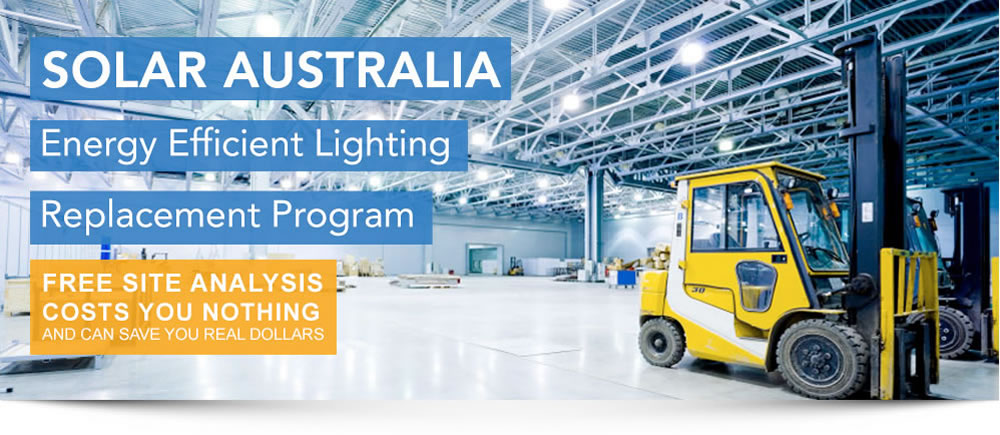If you’re in business, your lighting is costing you money. The fact is, unless your business is equipped with the latest lighting technology, you are likely paying more money each month than you should be. Our Energy Efficiency Lighting Replacement Program offers an obligation-free, no-hassle assessment of your site. Talk to the experts – it costs you nothing and can save you real dollars.
WHY CHANGE LIGHTING?
‘ENERGY EFFICIENT LIGHTING’ EXPLAINED
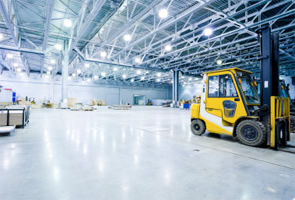 Most commercial buildings contain various lighting products which may have been considered efficient at the time of construction but have all been superseded by smarter lighting products, to which we refer generally as ‘Energy Efficient’ Lighting.
Most commercial buildings contain various lighting products which may have been considered efficient at the time of construction but have all been superseded by smarter lighting products, to which we refer generally as ‘Energy Efficient’ Lighting.
Fluorescent, Halogen and ‘discharge’ (factory) lighting have all been superseded by emerging technologies such as LED, T-5 fluorescent and induction lighting. Our job is to find the right quality alternative, not just a cheap imitation.
All of these lamp/lighting types produce a given amount of light (measured in lumens) but usually require unnecessarily high amounts of electricity to do so. What we do is to replace the light with something the better and one that uses much less electricity. As technology is moving extremely quickly in this field, it is essential for us to be across all advancements. No company is better connected to industry at this level than Solar Australia.
TRAPS AND PITFALLS
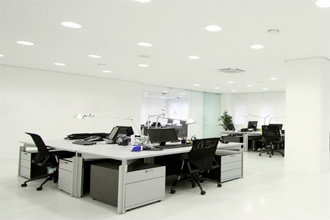 One of the traps is to be talked into a new lighting technology simply because it represents a ‘buzz word’ One such buzz word is LED. Like anything there are good (few) and not so good (many) LED products available. Just because LED is the name on many people’s lips, don’t automatically think that it will solve your problems. There are many examples of Halogen/LED retrofits that fail to live up to client expectations, that is, they simply are not bright enough and can be notoriously unreliable. These are LED lamps that are simply purchased because they were the cheapest, not because they were a viable alternative.
One of the traps is to be talked into a new lighting technology simply because it represents a ‘buzz word’ One such buzz word is LED. Like anything there are good (few) and not so good (many) LED products available. Just because LED is the name on many people’s lips, don’t automatically think that it will solve your problems. There are many examples of Halogen/LED retrofits that fail to live up to client expectations, that is, they simply are not bright enough and can be notoriously unreliable. These are LED lamps that are simply purchased because they were the cheapest, not because they were a viable alternative.
We focus on the solution to meet your needs; that is, we sell you what is best for you and your business.
Liability: It is important to bear in mind that lighting in the workplace contributes to safety, and needs to conform to the relevant Australian standard. If old lighting is not properly matched with new, then safety or proper workplace efficiencies can be adversely affected and open the way for liability exposure. If it is shown that minimum lighting levels are not being observed, your insurance may not cover an accident.
Solar Australia employs lighting professionals, not just generic sales people. We know what is best for you, and have access to the very best state of the art products. When we design a scheme for you, it will be without peer.
WHY CHANGE LIGHTING?
‘ENERGY EFFICIENT LIGHTING’ EXPLAINED
 Most commercial buildings contain various lighting products which may have been considered efficient at the time of construction but have all been superseded by smarter lighting products, to which we refer generally as ‘Energy Efficient’ Lighting.
Most commercial buildings contain various lighting products which may have been considered efficient at the time of construction but have all been superseded by smarter lighting products, to which we refer generally as ‘Energy Efficient’ Lighting.
Fluorescent, Halogen and ‘discharge’ (factory) lighting have all been superseded by emerging technologies such as LED, T-5 fluorescent and induction lighting. Our job is to find the right quality alternative, not just a cheap imitation.
All of these lamp/lighting types produce a given amount of light (measured in lumens) but usually require unnecessarily high amounts of electricity to do so. What we do is to replace the light with something the better and one that uses much less electricity. As technology is moving extremely quickly in this field, it is essential for us to be across all advancements. No company is better connected to industry at this level than Solar Australia.
TRAPS AND PITFALLS
 One of the traps is to be talked into a new lighting technology simply because it represents a ‘buzz word’ One such buzz word is LED. Like anything there are good (few) and not so good (many) LED products available. Just because LED is the name on many people’s lips, don’t automatically think that it will solve your problems. There are many examples of Halogen/LED retrofits that fail to live up to client expectations, that is, they simply are not bright enough and can be notoriously unreliable. These are LED lamps that are simply purchased because they were the cheapest, not because they were a viable alternative.
One of the traps is to be talked into a new lighting technology simply because it represents a ‘buzz word’ One such buzz word is LED. Like anything there are good (few) and not so good (many) LED products available. Just because LED is the name on many people’s lips, don’t automatically think that it will solve your problems. There are many examples of Halogen/LED retrofits that fail to live up to client expectations, that is, they simply are not bright enough and can be notoriously unreliable. These are LED lamps that are simply purchased because they were the cheapest, not because they were a viable alternative.
We focus on the solution to meet your needs; that is, we sell you what is best for you and your business.
Liability: It is important to bear in mind that lighting in the workplace contributes to safety, and needs to conform to the relevant Australian standard. If old lighting is not properly matched with new, then safety or proper workplace efficiencies can be adversely affected and open the way for liability exposure. If it is shown that minimum lighting levels are not being observed, your insurance may not cover an accident.
Solar Australia employs lighting professionals, not just generic sales people. We know what is best for you, and have access to the very best state of the art products. When we design a scheme for you, it will be without peer.
WHAT WE DO & WHY
LET’S START WITH THE ‘WHY’
It is more than likely that your business, no matter what the type, is equipped with Lighting that was selected as a balance between initial cost effectiveness and the available technology at the time. Thanks to rapid, recent advances in lighting technologies, there are products available to save you money, and these products may be made available at little or no upfront or ongoing cost. There are several reasons for this:
1. Correctly chosen lighting can save a massive amount of electricity, in turn reducing a commensurate amount of expenditure, saving you real dollars each month.
2. The initial investment in re-vamped lighting can be partially of set through ‘Energy Saving Certificates’ (ESCs) subsidised by the NSW government , once certain guidelines are met.
3. Solar Australia can offer an operating lease for the lighting that is paid for by the power savings, providing the further benefit of an ongoing tax deduction thus saving even more cash flow.
4. Please also note that your ongoing maintenance bill will be slashed as well.
Don’t assume that even if your building is new we can’t save you money. Some construction companies will opt for the cheapest upfront lighting options to manage the project build costs. We will assess your site against the latest energy-efficient lighting technologies and provide you with transparent, reliable financial data to determine the returns on your lighting upgrade investment.
Remember, as electricity costs continue to rise, your lighting continues to cost you more money than it should unless you act soon.
WHAT WE DO
We undertake a detailed analysis of all your building’s lighting and what it is costing you. We can break this figure down light fitting by light fitting, if need be. Subsequently, a recommendation is made based on the best quality alternatives available to you, with a cost benefit analysis attached. If your building is eligible (and most are) we then apply the NSW government ‘Energy Saving Certificate’ (ESC) rebate which reduces the investment cost even further.
The last step is to furnish you with an operating lease finance option, of which payments are fully tax deductable. The aim is to come out with a cash positive (best result) or break-even scenario so that after the payback period your new lighting installation is making you money.
LIGHTING TYPES PROS & CONS
There are a number of energy saving lighting technologies available. Not all types are suitable for all applications of course. In this section we categorise some of the more common commercial and industrial environments and show the pros and cons of each.
Factories – Storage And Production Facilities
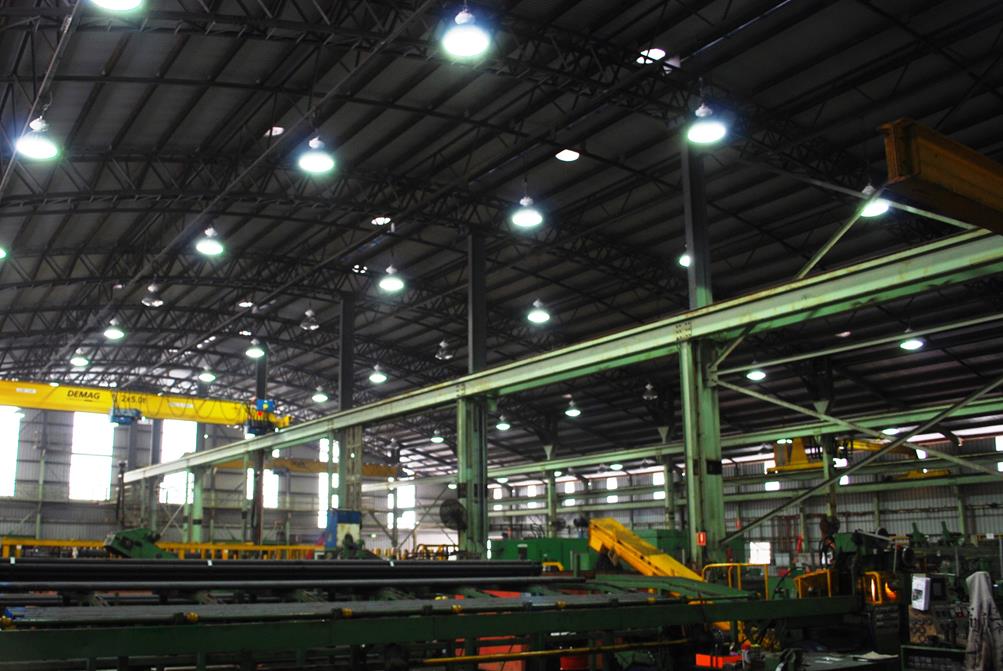
Current technology is usually a ‘high bay’ type light, a large bell shaped fitting. These feature ‘discharge lamps’ in either Mercury Vapour or Metal Halide lamp configuration.
Older Technologies – Mercury Vapour lamps
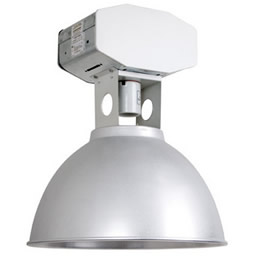
Pros
Cheap to purchase and install with reasonable lamp life
Not affected greatly by higher ambient temperatures
Cons
Poor colour rendering (CRI)
Expensive to maintain due to access issues
Not efficient compared to different technologies
Take time to reach operating efficiency and will not re-start for several minutes when a ’black out’ occurs
Not suitable for use with movement sensors
Metal Halide lamps
Reasonable lamp life and good colour rendering
More efficient than Mercury Vapour
Cons
Take time to reach operating efficiency and will not re-start for several minutes when a ’black out’ occurs
Expensive lamps to buy and maintain (access issues as well as cost of replacement lamps)
Not suitable for use with movement sensors
Replace with?
For higher ceilings we recommend either LED or Induction Lamp ‘High-bays’. For medium to lower ceilings use either LED, Fluorescent or Induction ‘Low-bay’ luminaires.
For higher ceilings – 6+ metres:
LED Highbay’s
Lumen output on par or exceeding with Metal Halide (higher quality units only)
High service life
No maintenance required
Instant start (suitable for use with movement sensors) and instant full level of luminance on start up
Not affected by shock or vibration
Good CRI and colour temp choices
Cons
Not tolerant to higher ambient temperatures (not the best choice for use in very hot factories such as smelter works etc.)
Full replacement usually required at the end of service life
Caution: Avoid lesser quality units – they can be unreliable and prone to premature failure
Induction Lamp High Bays
Usually cheaper to buy than LED highbay
Instant start (suitable for use with movement sensors)
High service life (50,000 to 100,000 hours)
Not affected greatly by higher ambient temperatures
Long service life for lamp and lamps are replaceable
Good CRI and colour temp choices
Cons
None really as long as a good quality unit is sourced: Lesser quality units are less efficient that conventional lamp sources and are prone to premature failure – Solar Australia imports a high quality Induction range with a five year warranty
MOVEMENT SENSORS
Most factories can benefit further with the introduction of high quality movement sensors. Once The Highbay lights are replaced with LED or Induction, further cost savings are achieved with the clever deploying of sensors so that only those lights needed at any one time are switched on. Movement sensors are not suited to use with conventional discharge lamps
FOR lower ceilings – 3 to 6 metres max:
LED and Induction ‘low bays’ or Fluorescent high and low bays
LED and Induction pros and cons as per ‘Highbay’s’
Fluorescent ‘T-5’ low and Highbay’s
These types of fittings resemble large rectangular boxes with two, three, four or five ‘T-5’ fluoro tubes, backed by a highly polished aluminium reflector.
More efficient than conventional fluoro tubes
Good colour rendering and CRI
Good service life (up to 20,000 hours) and lamps are replaceable and easily sourced
Cons
Not suitable for high ceilings
Highly polished silver reflectors are essential for high output levels and these can deteriorate in harsh environments such as in coastal areas, chemical manufacturing facilities and factories with high levels of ‘dirty air’ such as processing plants of various types
Tubes will eventually require replacement and this may be difficult in factories with high ceilings.
What is the difference between a conventional fluorescent tube and a ‘T-5’ tube?
‘T-8’ and ‘T-5’ actually refer to the size of the lamp in imperial terms, that is a T8 is 8 eighths of an inch in diameter, a T5 is 5 eighths of an inch. It is important to note that T-5 lamps require different ballasts/transformers to T-8’s, and are shorter, therefore they cannot simply be clipped into existing light fittings designed for T8.
A T-8 is the most common type of lamps sold over the last 30 years or so; T-5 is newer technology, and as light efficiency is measured in ‘lumens per watt’, we find that it (the T5) produces more light from each watt of electricity consumed, but is far more expensive to by (can be up to 5 times the cost).
Efficiency of fluoro tubes vary widely dependent on quality and type (different colour lamps have different lumen per watt figures) but generally speaking, a T-8 produces around 90 lumens per watt, but a T-5 up to 120 lumens per watt.
Until recently it has become popular to retrofit T8 lamped Fluoro’s with T-5 conversion kits. This is relatively inexpensive, but many of these kits have proven to be unreliable. Site costs and inconvenience is also a factor. Because of this reliability issue, and the fact that a retrofitted fluoro fitting no longer complies with Australian standards, the NSW government has withdrawn its approval for these types of conversions, and they are no longer approved for Energy Saving Scheme certificates (ESCs).
Office Lighting

For medium to large offices one would invariably find fluorescent lights, either ‘surface mounted’ or recessed. Most commercial offices are fitted out with ‘T-Bar’ (grid) ceilings with pop out light weight tiles. Within these grids are fitted ‘recessed troffer’ lights, usually 1200 x 300mm, but sometimes 600 x 600mm, or 600 x 300mm, or even 1200 x 1200 (rare).
Usually these are fitted with 36W tubes (T-8) and copper wound ballasts, although more recent fit outs may feature electronic ballasts and ‘T-5’ tubes. When calculating the energy consumption of existing lighting it is important to understand that older fluorescent ballasts can consume up to 15 watts per ballast! This means a fitting with two 36 watt tubes and 2 x 36 watt ballasts is potentially consuming as much as 102 watts, so this needs to be taken into account when calculating potential savings.
T-5 Tubes
Existing units can be replaced with new units featuring T5 lamps, but strictly speaking existing fittings should not be retrofitted with T5 conversion kits (Please see the section above dealing with fluoro lamp types).
Replacement T-5 lamps should be 28 watts, and the electronic ballast will consume a maximum of 5 watts (usually a little lower), so whilst there may be only 8 watts difference per lamp, the full saving on each light (2 x 36) may be as high as 36 to 40 watts.
Relatively inexpensive solution
Good lamp life (approx. 20,000 hours from quality tubes)
Potential savings in excess of 25% over the original light fitting
Cons
When disposing of old T-5 tubes care has to be taken as these contain mercury
There is new technology that yields better results (see LED)
Replacement LED tubes
These are a potential solution for a refit that can be beneficial, but there are many traps for the unwary. Firstly, not all LED tubes work well, and they don’t all work in the same manner. Second, refitting an LED tube can cancel out its compliance with Australian Standards.
Quality LED tubes will give a similar light to the existing tubes, or even higher,, but often this is achieved through utilisation of ‘cold’ colour temperatures to raise lumen levels. Quality LED tubes from a reputable supplier can be sourced in neutral (4000k) white, which tends to be the commercial standard, or a warmer colour (3000k) if required. Reliability is also an issue with LED tubes; cheaper versions from generic manufacturers can have a high failure rate
Remember also that fluoro tubes give light from their entire surface area, most LED tubes do not. In a recessed fitting the light bouncing out from the reflector behind the tube contributes to the overall light levels; LED tubes that only emit from below may not provide adequate light levels.
If considering such a tube, insist on trialing one in your light for a week or two to ensure you are happy with the result.
Long life
Lower running costs
Good performance
Cons
There are more poor quality LED tubes in the market place than good
Sometimes fitment is not as straight forward as clipping them into place as the light fitting may need modification
Performance may not be up to expectation in recessed fittings -this needs to be ascertained before purchase
Designated LED recessed and surface mounted lighting
Until quite recently, these types of fittings were rare, as LED’s could offer the same or better lumen output to fluorescent lamps. That has changed, and there a few companies producing recessed fittings that can provide the same levels of lighting as recessed troffers but use approximately half the amount of electricity, or less. Again, reputable sellers need to be consulted as the dangers that exist with these types of units are the same as replacement LED tubes.
Long life
Lower running costs
Zero maintenance requirements
Good performance
Vastly superior to T5 lamps
LED fittings run cool so there are minimal loads of the air-conditioning
Cons
Price of complete light fittings compared to T5 units (but this is usually off set by greatly reduced energy consumption)
The entire light fitting may have to be replaced after 70,000 to 100,0000 hours
Same risks apply as for purchasing LED tubes – try before you buy!
Downlights and Pelmet Lighting (dealt with under the heading below)
Banks, shops and public areas of all types
Most other buildings have a greater array of lighting than offices and warehouses, particularly shops and shopping centres. Let’s deal with SHOPS.
Retail shops (other than heavy goods and warehouse centres) generally have a variety of downlights, usually predominately Halogen.
Halogen – Dichroic Halogen lamps created a sensation when introduced in the early 80’s. They were much smaller than anything that came before, and came with their own built in reflectors. The term dichroic refers to the type of glass the lamps are made from.
‘MR-16′s’ come in 20W, 35W and 50 watts, the later 35W variants tending to be the most efficient. In the not too distant future such lamps will be banned from sale in Australia, as soon as a cost effective (dollar for dollar) replacement is available. This time is not far away.
MR16 Halogen lamps come with transformers (rather like fluorescent ballasts) which also consume power. Older, copper wound (heavy to pick up) types use as much as 18 watts, so the unit could be consuming as much as 68 watts. Later electronic types consume up to around 5 watts (total 55 watts) so these needs to be taken into account when calculating potential savings.
LED replacements
Halogen downlights can be re fitted with LED lamps of the same size, but at this time these do not give comparable levels of light. Normally a much larger (higher) lamp is required as a large heat sink needs to be integrated with the lamp if comparable amounts of light is needed (and it usually is!). These ‘replacements’ are not compatible with all types of downlights, so check size first.
Make sure that any lamp considered is compatible with the existing transformer, as most are not, and a new transformer (actually correctly termed ‘driver’) is required. N.B a driver is both a transformer and voltage regulator built into the one unit.
Solar Australia has such a replacement lamp and ‘driver’ rated at 10 watts (12 watts with driver) which compares favourably to most 50 watt dichroic lamps. We have higher powered units (exceeding the output of halogen) as well.
The same rules apply to LED downlight replacements as any LED product: try before you buy!
Compact Fluorescent Downlights
Compact Fluoro’s (CFL’s) are relatively low consumption but tend to be inefficient when placed into downlights, due to restrictive shape and size. The lamps require replacement every 10,000 hours or so.
It is important to also remember when calculating replacement choices and energy savings that these downlights have ballasts just like conventional linear fluoro’s. These ballasts can use up to 25% as much energy as the lamp (an 18 watt lamp ballast can use up to 5 watts, meaning that circuit is actually consuming 23 watts).
It is also important to match the lamp ‘colour temperature’ with an LED of the same rating. Most fluoro lamps have a colour temperature of approximately 4000 degrees Kelvin. If a warmer tone is required (as fluoro’s tend to be a little ‘cold’) then opt for 3000K, which is a much ‘warmer’ tone.
Replace with?
LED replacements are widely considered the best choice. Once you determine the wattage of your lamps (this will be written somewhere on the lamp) speak to an expert as to the best choice. Solar Australia can provide Australian-made 12 watt LED downlights with comparable outputs to an 18 watt ‘CFL’ lamp, an 18 watt LED downlight that betters a 26w CFL, a 26W LED downlight that betters 2 x 18W CFL downlights and so on.
Pelmet Lighting
Pelmet Lighting was once always a series of fluorescent tubes butted together, most recently T8 or T5 lamps. The advantages were good lamp life and relatively low energy consumption, but just like all other older fluorescents, there are better choices available now.
If you have older fluorescent installations, they are no doubt looking patchy and tired. One of the issues is the dark spot that appears between fittings, and this can be addressed in one of two ways: Solar Australia has Fluoro Pelmet Kits that are staggered so that bright spots are taken care of, or (better still) use a quality LED strip that has the same lumen levels as the fluorescent tubes, but these would be more expensive. If using LED, the other important thing is to get one with a clear cover, as bare LED’s are almost impossible to clean, and cleaning (once per year) is absolutely necessary. Solar Australia has the right fittings if LED is your preference.
Another issue is the different colour/quality of light from existing fluoro tube to tube. This happens as a result of changing lamps one at a time when they fail, not all as a block (which is the way to do it).
Halogen and Metal Halide Adjustable Shop Lights
These fittings are often used in window displays, and sometimes right throughout a shop. Popular in clothing shops and boutiques, the disadvantages are many, and the advantages are few! Halogen have short lamp life and are expensive to run but do give warm colour; metal halide are slow to start, do not restart in a black out for several minutes (which has security and safety implications) and are expensive lamps to replace. They do give good CRI, (which is important when selling clothes, soft furnishings and so on) and they give good lumen-per-watt figures.
Replace with?
LED shop lights are the best option, provided they are good quality (like any LED).
Highly efficient
Low running temperature
Different colour temperatures are available
Very long service life (50,000 hours plus)
Quick start and instant start
Con’s
It is likely the entire light fitting will need replacing when the LED ultimately fails – although this may be in ten years or more depending on trading hours
Metal halide recessed downlights
These fittings are often used as common lighting in shopping centres for higher levels of light. They can be found in motor vehicle showrooms, commercial offices, hospitals and so on.
They were once, and according to many, still are the best choice for high lighting levels with minimum consumption, but recent improvements in LED technology are threatening to render them obsolete. One of the big disadvantages (as for any metal halide lamp) is the fact they take time to reach full brightness on start up, and will not restart for several minutes after a brown out.
Reasonable lamp life and good colour rendering
More efficient than halogen and other discharge lamp types
Cons
Take time to reach operating efficiency and will not restart for several minutes when a ’brown out’ occurs
Expensive lamps to buy and maintain (access issues as well as cost of replacement lamps)
Replace With?
High quality LED downlights. These are not available from all suppliers, certainly not the type needed to compete with halide lamps. Talk to Solar Australia about the best downlights for your needs.
Good quality units provide lumen output on par or exceeding with Metal Halide (higher quality units only)
High service life
No maintenance required
Instant start (suitable for use with movement sensors) and instant full level of luminance on start up
Not affected by shock or vibration
Good CRI and colour temperature choices
Con’s
None really (assuming a high quality product is sourced) other than the entire fitting may have to be replaced at the end of the service life
EXTERNAL FLOODLIGHTING
Exterior floodlights generally fall under the following types, listed in order of ‘popularity’
- Halogen – instant start, available in a very broad range of wattages, warm colour quality and instant strike; ideal choice for infra-red triggered security lighting. Not efficient and expensive to run. Comparatively short lamp life.
- Par lamps – as above but confined to wattages from 75 to 300watts.
- Metal Halide – high outputs, long lamp life, good colour rendering.
- High pressure sodium – characterised by distinctive orange colour, helps visibility in foggy and wet areas, often used as street and tunnel lighting. Relatively economical and long lamp life, but effectively low in lumens per watt.
Replace With?
LED floodlights can be swapped for any of the floodlights described above. Some floodlights are mounted in very high or difficult to reach locations, thus can be expensive to replace. Often flood lights are not re-lamped for this reason.
Led floodlights can be sourced to replace small ‘PAR’ lamps right up to the largest metal halide lights used at sporting ovals and the like.
Solar Australia has access to the best LED floodlights available on the Australian market. Once we establish what you have installed we will find a replacement that will use much less electricity.
Glossary of terms
Brown out – temporary interruption to power.
CRI – (colour rendering index) the ability of a lamp to reveal colours as if lit by natural light. The higher number the better.
Discharge lamps – (Mercury Vapour, Metal Halide, High pressure sodium) lamps that generate light by discharging a current through an ionized gas.
Induction lamps – these are a gas discharge lamp in which the power required to generate light is transferred from outside the lamp envelope to the gas inside via an electric or magnetic field.
Instant strike – the ability for a lamp to switch on immediately after an interruption to power.
Kelvin – this is a degree of measurement in which the colour of light is measured. The higher the number the bluer the light, the lower, the redder.
LED Driver – A low voltage transformer and voltage regulator built into one unit. These are required for use with LED light fittings.
Lumens per watt – how many lumens a lamp produces per watt of electricity consumed (the higher the better).
Lux level – the level of light present at any given point measured in ‘lumens’.
Movement sensor – a switch which activates a circuit when movement is detected nearby.
Recessed Troffer – a light fitting recessed into a ceiling so that only a flat diffuser panel or louver is visible.



